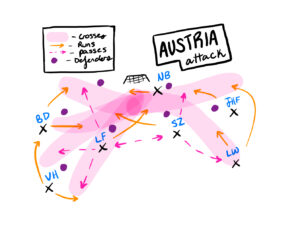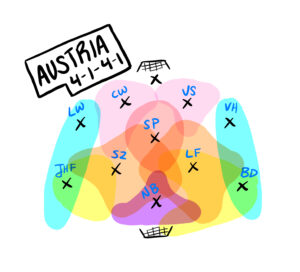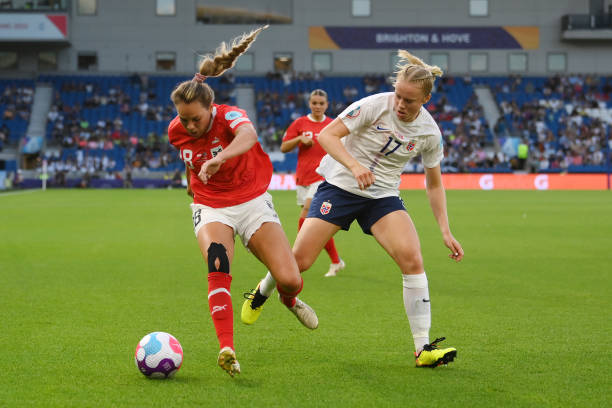An analysis of Austria vs. Norway
July 15th, 2022
Final Score: Austria 1-0 Norway
Austria regularly outperforms expectations. Their run to the Euros semi-finals in 2017 was justified in their clash against Norway in the quarter finals last year. This analysis will discuss Austria’s organization and tenacity which ultimately lead to a host of unfortunate events for the Nordic giants.
Wide Overloads
Embed from Getty Images
A recognizable feature of the Austrian attack is their wide movements. Outside backs Laura Weinroither and Verena Hanshaw orchestrate combination play in advanced areas to progress the ball towards Norway’s net. As a result, Austria’s wide forwards tuck in, allowing Weinroither and Hanshaw the entirety of the flanks. This creates a midfield overload. Attacking midfielders Sarah Zadrazil and Laura Feiersinger are subsequently given the freedom to take up space in the areas left by the wide forwards.
Zadrazil and Feiersinger are masters at both combination play and distribution. They create passing triangles with their attack-minded outside backs and inverted wingers. Through these combinations, Austria can isolate a Norwegian outside back or center back to ultimately play in behind or into the half-spaces in front of Norway’s box.
Zadrazil and Feiersinger

In a nutshell, there are three options that Zadrazil and Feiersinger can chose to take advantage of:
The first option is for Zadrazil or Feiersinger to play the ball back to their outside back, now occupying a space either between a Norwegian center back and fullback or in front of the fullback. They can do this by switching the field in the middle third until an opening arises to attack. Commonly, Zadrazil or Feiersinger will break lines themselves through dribbling or short passes between each other. As both Hanshaw and Weinroither are adept at crossing from deeper areas, Austria do not need to drive end-line or into Norway’s box. Crosses are expertly floated in towards the head of Nicole Billa or a midfielder making a run from a deeper area.
Nicole Billa is the main target for Austria to score. Billa cuts in from deep or wider areas to get between the center backs. Her head is a primary target for the Austrian outside backs or forward wingers crossing from wide areas.
Embed from Getty Images
The second option for Zadrazil or Feiersinger is to play into one of their inverted wingers. Against Norway, these wingers consisted of Barbara Dunst and Julia Hickelsberger-Füller. Both of these players are speedy with tricky feet to knock a defender off balance. Dunst in particular is capable of taking long-range shots from outside the box that involve her cutting in on her right foot to hook the ball towards the far post. Both Dunst and Hickelsberger-Füller often cross the ball through similar movements.
The third option is for Zadrazil or Feiersinger to shoot themselves. Austria mostly rely on long-range shooting with the exception of Nicole Billa who is their main threat inside the box.
Norway’s Struggles and Austria’s Defense
Embed from Getty Images
Wide overloads worked well against a centralized Norway. With Caroline Graham Hansen in attacking midfield and an inexperienced back-line, Norway were exposed in wide areas. Additionally, Graham Hansen’s usual flair was lost in her role as a second striker/attacking midfielder behind Hegerberg. This was a huge let-off for an Austrian side without sufficient cover behind their outside backs.
Frida Maanum and Ingrid Engen formed a double pivot for the Norwegians. With Maanum’s creativity stifled by not pushing forward and Engen’s distribution hindered by lack of movement, Zadrazil and Feiersinger could easily bypass the midfield block. Due to the lack of threat imposed by Maanum and Engen, Zadrazil and Feiersinger were also able to defend wider areas.

This meant that the space left by Weinroither and Hanshaw pushing up were taken care of. This is especially critical with a winger like Guro Reiten who can create an assist from pinpoint passes in very deep areas. With Graham Hansen as a sort of false nine, Ada Hegerberg was a presence in midfield. When she dropped into the midfield to collect the ball, this is where Sarah Puntingham came in. Puntingham, with the tracking back of either Zadrazil or Feiersinger, was largely able to take care of chance creation in front of Austria’s box.
Puntingham had a number of roles in this match. Her long-range passing ability and defensive security allowed both Zadrazil and Feiersinger to occupy more advanced areas or pull out wide. Puntingham is crucial in allowing Austria to bypass Norway’s first line of press. Center-back Carina Wenninger is also adept at breaking lines. Her dribbling as well as long-range passes provide a quasi-second distributor in defensive central midfield.
Conclusion
Each team at the World Cup this summer deserves their place. However, I personally believe Austria can challenge even the most talented squads. The next step for Austria will be beating opposition as opposed to stifling opposition or simply creating chances. As proven against Norway, names that are largely ignored by the wider soccer community really do stand a chance against the world’s best.
Written by Madeleine Metz
Creator of Only Women’s Soccer
